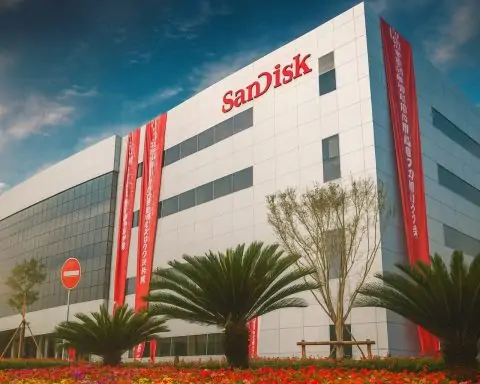- Sharp Rally & Pullback: Sea Limited (NYSE: SE) shares closed at $163.42 on Oct. 15, 2025, after tumbling 9.6% in one day [1]. The drop came on the heels of a sharp 2025 rally that saw SE near its 52-week high of ~$199 (versus a low around $92) [2]. Even after the pullback, the stock remains up roughly 72% year-to-date, though volatility has spiked this week.
- Blowout Earnings Growth:Q2 2025 results impressed – revenue jumped 38.2% year-on-year to $5.26 billion, beating estimates [3]. All three core businesses delivered robust growth: Shopee e-commerce sales up 33.7% (to $3.8 billion), Garena gaming bookings up ~23%, and digital finance (SeaMoney/Monee) revenue up 70% [4]. CEO Forrest Li said “all three of our businesses have delivered robust, healthy growth,” fueling confidence for “another great year” [5] [6].
- Business Momentum: Shopee, Sea’s e-commerce arm, turned profitable in late 2024 and has stayed in the black since [7]. It continues expanding across Southeast Asia and Brazil, aided by new social shopping features and competitive pricing to drive engagement [8]. Garena’s flagship game Free Fire is seeing a resurgence – paying users jumped 18% and bookings are on track for >30% growth this year [9]. Sea’s fintech unit (formerly SeaMoney, now “Monee”) also boomed, with digital wallet, payments, and lending services helping fintech revenue soar 70% in Q2 [10].
- Analysts Mostly Bullish: Wall Street largely remains upbeat on SE. 17 out of 17 tracked analysts rate the stock a “Buy” or “Hold,” with a consensus Moderate Buy and an average 12-month price target around $177 [11]. Notably, JPMorgan raised its target to $230 (Overweight) in September, citing Shopee’s improving monetization and efficiencies in logistics [12]. However, a few are cautious on valuation – e.g. Arete Research cut to Neutral with a $177 target, warning that after a 300%+ run since early 2024, “much of the good news is priced in.” [13]
- Competitive & Market Headwinds: Sea faces intensifying competition in its markets. Alibaba’s Lazada and ByteDance’s TikTok Shop are aggressively vying for Southeast Asia’s e-commerce shoppers, while regional players like Indonesia’s GoTo (Tokopedia) and ride-hailing super-app Grab are expanding fintech and e-commerce offerings. Governments are stepping in too – for example, Indonesia’s new rule will require platforms like Shopee to collect a 0.5% tax on small-seller transactions [14]. Geopolitical and macro risks (from U.S.-China tensions to global tech selloffs) are a overhang, and Sea’s rich valuation (~94× earnings) leaves little room for error [15] [16].
- Looking Ahead:Q3 2025 earnings are due around Nov. 11, 2025 [17]. Investors expect continued double-digit revenue growth and a triple-digit percentage jump in earnings as Sea laps last year’s profitability milestone [18]. Key factors to watch include Southeast Asia’s holiday shopping season (a major catalyst for Shopee), Sea’s marketing spend versus growth trade-off, and any new product initiatives or regulatory changes. With the stock still trading well above early-2025 levels, the big question is whether Sea can sustain its breakneck growth without tripping up on rising costs or competition.
Stock Surge and Recent Price Movement
Sea Limited’s stock has been on a rollercoaster in 2025. After a brutal 2022–2023 downturn, SE staged a stunning comeback – by August 2025 the share price had more than quadrupled from its early-2024 lows, even briefly overtaking DBS Bank as Southeast Asia’s most valuable public company [19] [20]. Optimism about Shopee’s profitability and a regional tech rebound propelled Sea’s stock to a 52-week high of ~$199 in early October. However, this week the momentum snapped: on October 15, SE plunged ~10% intraday, falling from about $184 in the morning to close at $163.42 [21]. This one-day drop erased weeks of gains and was “in line with a broader tech selloff,” as investors took profits on high-flying growth stocks amid jittery market sentiment [22].
Despite the pullback, Sea’s stock is still up roughly 80% in 2025 and trading well above its spring levels [23]. The 52-week range of $92.50–$199.30 underscores how far it has climbed from last year’s pessimism [24]. Market watchers note that at these levels Sea’s valuation looks stretched – the stock trades around 94× trailing earnings [25]. That lofty valuation means big growth is already priced in, and any disappointment could hit the stock hard. Technically, traders are eyeing the $160 level as near-term support, while wondering if the recent dip is a healthy correction or a warning sign. Institutional investors own nearly 60% of SE’s float [26], reflecting strong buy-side conviction, but also raising the stakes: if sentiment sours, these same large holders could rotate out quickly. In short, Sea’s spectacular rally has given way to increased volatility, setting the stage for a crucial next few weeks.
Financials and Business Developments
Sea Limited’s latest financial results show a company firing on all cylinders. In Q2 2025, Sea’s revenue surged 38% year-over-year to $5.26 billion, handily beating analysts’ estimates of ~$5.0B [27]. The top-line growth was powered by stellar performance across all three of Sea’s core segments:
- Shopee (E-commerce): Once a cash-burning expansion play, Shopee has pivoted to balancing growth with profitability. Revenue for Shopee’s platform jumped 33.7% YoY to $3.8 billion in Q2 [28]. Notably, Shopee achieved sustained profitability by Q3 2024 and has remained profitable since [29], a milestone attributed to disciplined cost controls and rising monetization. The company cut back on subsidies last year and improved logistics efficiency (through its in-house courier network SPX Express), which helped turn the e-commerce unit profitable. Now, Shopee is re-accelerating growth: it’s adding new “social commerce” features like live-streaming and in-app games to boost user engagement [30], and it continues to expand in Latin America (especially Brazil) and smaller Asian markets. Gross merchandise value (GMV – the total value of goods sold) rose ~28% in Q2, and executives said full-year GMV growth will comfortably beat their initial ~20% target [31] [32]. “We expect Shopee to remain profitable going forward,” CEO Forrest Li assured investors recently [33] – a signal that Sea intends to keep its e-commerce business in the black even as it chases market share.
- Garena (Digital Entertainment): Sea’s gaming division, Garena, is seeing a renewed growth spurt after a pandemic-era dip. Q2 gaming revenue grew 28.4% YoY to $559 million [34], as Free Fire – Garena’s hit battle-royale mobile game – enjoys a second wind. The game’s user metrics are rebounding: paying users jumped 17.8% and bookings (in-game spending) climbed ~23% last quarter [35]. Garena even upgraded its outlook, with Forrest Li telling analysts that bookings are now on track to grow “more than 30% this year” [36]. This gaming recovery is significant for Sea’s bottom line: Free Fire was a cash cow in the late 2010s, and its slowdown in 2022 hurt Sea’s profits. Now, improving gaming results are “underpinning Sea’s profits”, analysts note [37], providing cash that Sea can reinvest in Shopee and fintech. There are still questions about how long Free Fire can hold its throne (competition in gaming is fierce), but for now Garena is a sturdy second pillar of growth.
- SeaMoney (Digital Financial Services): Sea’s fintech arm – recently rebranded as “Monee” – is the fastest-growing part of the business. Q2 revenue for digital financial services soared 70% to $883 million [38], outpacing even Shopee’s growth. Initially built around the ShopeePay wallet, Monee has evolved into a broader fintech platform offering mobile wallets, payments processing, consumer lending, digital banking, and even insurance. These services are often integrated with Shopee’s ecosystem (for example, offering Buy Now Pay Later loans to Shopee shoppers). Sea is doubling down on fintech expansion: in May 2025 it opened a new fintech headquarters in Singapore to develop Monee’s products and regional infrastructure [39]. The Singapore government has praised Sea for establishing fintech “centers of excellence” locally [40], underscoring Sea’s role in the fintech boom. This year Sea also obtained new digital banking licenses in Southeast Asia and even Latin America – for instance, it secured approvals in Brazil to expand its lending and banking offerings there [41]. The hefty fintech growth suggests Sea’s strategy to become more than just an e-commerce company is paying off. Importantly, fintech services could enhance customer stickiness across Sea’s platform (by giving unbanked users access to credit, for example) while opening new revenue streams.
All told, Sea’s operational turnaround from 2022’s losses has been dramatic. Last year, management slashed costs – freezing hiring, cutting marketing spend, and even reportedly reducing executive salaries to $1 – to stem losses. Those moves pushed Sea into profitability in late 2024. Now in 2025, with cost discipline in place, Sea has been able to scale back up growth investments. The Q2 numbers reflect that balance: aggressive revenue expansion with improving margins. Sea posted a GAAP net profit of $414 million in the first half, a stark reversal from heavy losses two years ago [42]. “All three of our businesses have delivered robust, healthy growth, giving us greater confidence of delivering another great year,” CEO Forrest Li proclaimed after Q2 [43]. That confidence is evident in Sea’s actions: the company has cautiously resumed some marketing campaigns and growth initiatives, even as it vows to remain prudent. The challenge ahead will be maintaining this momentum – and profitability – as competition mounts.
Southeast Asia Tech Landscape and Competition
Sea Limited’s fortunes are closely tied to the broader Southeast Asian digital economy, which remains one of the fastest-growing in the world. Across Indonesia, Singapore, Vietnam, and neighboring countries, millions of new consumers are coming online and shopping on apps like Shopee each year. A report by Google, Temasek and Bain projected Southeast Asia’s internet economy will more than double by 2030, with e-commerce climbing from about $100 billion in 2020 toward $300 billion mid-decade [44]. In Indonesia alone – Sea’s single largest market – e-commerce gross merchandise value was about $65 billion last year and is expected to reach $150 billion by 2030 [45]. This rising tide lifts all boats, and as the region’s leading internet company, Sea has been a prime beneficiary of the digital boom.
However, competition in the region is fierce and only getting tougher. Sea’s Shopee faces an onslaught of rivals large and small in e-commerce. Alibaba’s Lazada, backed by the Chinese tech giant’s deep pockets, is the most direct regional competitor and has been investing heavily to grow in Southeast Asia. Lazada is especially strong in markets like Thailand and Malaysia and is raising seller commission fees aggressively this year – a sign that it, like Shopee, is pushing to monetize its platform after years of chasing growth [46]. Another formidable foe is ByteDance’s TikTok Shop, which leveraged the popular TikTok social media app to sell products via livestreams and short videos. TikTok Shop gained huge traction in Indonesia and Vietnam by blending entertainment with shopping, forcing Shopee and Lazada to respond with their own live-stream shopping features. (Notably, TikTok’s e-commerce push hit a roadblock in Indonesia recently: regulators banned direct shopping on social media platforms to protect small merchants, a move that clipped TikTok Shop’s wings in its top market. Shopee potentially stands to regain some ground from that ban.) Domestic players also crowd the field: in Indonesia, Tokopedia (part of GoTo Group, formed by the merger of ride-hailing app Gojek and Tokopedia) remains a powerhouse in online retail, and in Vietnam local e-tailer Tiki.vn competes for consumers alongside Shopee and Lazada.
Sea’s management is well aware of these pressures. The company has cited competition as a reason it must keep investing in user experience and pricing. Shopee has periodically ramped up marketing spend (like free shipping promotions or vouchers) to defend its market share – a strategy that can boost growth but at the expense of margins. This year, Shopee’s competitors have also begun monetizing through higher fees, which ironically could help Sea: JPMorgan analysts noted that industry-wide fee increases are “positive momentum” for Sea’s business model, as they allow Shopee to raise its own take-rates without losing competitiveness [47]. In other words, if Lazada and TikTok Shop also charge sellers more, Shopee has cover to do the same, supporting its profitability [48]. Still, the battle for Southeast Asia’s online shoppers is far from over, and it extends beyond retail.
In the digital finance and payments arena, Sea’s up against other regional tech giants. Singapore-based Grab – known for ride-hailing and food delivery – has transformed into a super-app offering e-wallets, insurance, and lending. Grab’s fintech arm (GrabFin) and its OVO e-wallet in Indonesia compete with Sea’s Monee for users’ transactions and financial services. Similarly, Indonesia’s GoTo offers GoPay, and even traditional banks (like Singapore’s DBS or Thailand’s Kasikorn) are rolling out slick mobile apps to defend their turf. Sea’s advantage is the synergy between Shopee and Monee – it can leverage e-commerce data to underwrite loans or funnel shopping customers into using its wallet – but fintech competition is intensifying. In some markets, Sea has partnered with local banks for digital banking, while in others it’s going solo with online-only banks. The prize is huge: hundreds of millions of unbanked consumers in Southeast Asia are coming online, and whoever wins their digital wallet share could ride a massive wave of growth.
It’s not just regional players to watch, either. Global companies have their eyes on Southeast Asia’s growth. There are rumors of Amazon exploring expansion in the region, and Chinese bargain marketplace Pinduoduo has launched “Temu,” a shopping app that quietly entered markets like Singapore and Malaysia with ultra-low prices. While Sea is the incumbent leader in many of its verticals, it must execute shrewdly to fend off this crowded competitive field. The good news for Sea is that the market itself is expanding quickly (so multiple players can thrive), and so far, Shopee has proven resilient. As one Bloomberg Intelligence analyst put it, “record sales in August underscored [Shopee’s] ability to fend off rivals such as TikTok’s shopping business and Alibaba-owned Lazada.” [49] Sea will need to keep innovating to maintain that edge.
Analyst Sentiment and Investor Outlook
Despite the recent turbulence in SE’s share price, analyst sentiment remains broadly positive. Dozens of analysts from global banks and research houses cover Sea Limited, and the consensus rating in mid-October 2025 is a “Moderate Buy,” with most analysts recommending buy or overweight and a handful on hold [50]. The average 12-month price target across Wall Street is roughly $177 per share [51], implying moderate upside from current levels. That average conceals a wide range of views, however. Bullish analysts argue that Sea’s high growth justifies a premium valuation and that the company’s dominance in e-commerce/fintech gives it a long runway. Bearish voices (or the few neutrals) counter that the stock’s rapid ascent has priced in years of growth and leaves little margin for error.
Several high-profile analysts have recently updated their calls on SE. In September, JPMorgan’s team reiterated their upbeat stance, raising Sea’s price target from $208 to $230 and maintaining an Overweight rating [52]. They cited Shopee’s accelerating monetization (pointing to higher commission fees and ad revenues on the platform) and improving unit economics in logistics. In a note, JPMorgan highlighted that industry trends “should allow Shopee to unlock advertising revenues and benefit from reduced logistics costs,” leveraging its scale [53]. Barclays also lifted its target to $214 (Overweight) after Q2 results, and Singapore’s local banks DBS and Maybank reportedly issued Buy ratings with aggressive targets in the high-$230s [54]. Even the more cautious firms nudged their numbers upward – for instance, Bank of America kept a Neutral rating but bumped its target from $200 to $206, noting Shopee’s recent fee hikes and the fact that Sea’s earnings held up even as it offered more discounts [55].
On the other side, a few dissenting analysts urge caution. Small research outfit Arete downgraded Sea to Neutral in early September, deeming the stock fully valued around the high-$170s [56]. Their report noted Sea’s share price was “up an impressive 72.3% year-to-date” and argued it “remains fairly valued” relative to expected profit growth [57]. In plainer terms: Sea’s execution has been excellent, but any slip – whether a growth slowdown or a margin miss – could trigger a correction now that the valuation is no longer cheap. Some analysts also worry about competitive pressures eventually eroding Sea’s growth or forcing it to spend more on marketing.
Investor sentiment on the stock has seesawed alongside the price. Earlier in 2025, sentiment was euphoric – Sea’s surprise return to profitability and mega-growth quarter led to a rush of investment; the stock at one point nearly doubled in three months, and options activity spiked with traders betting on further upside. By mid-October, sentiment has become more mixed: the steep drop on Oct. 15 showed jitters about lofty valuations and possibly some pre-earnings profit-taking. Short interest in SE remains relatively low (Sea is not a heavily shorted name), but it may tick up if skeptics grow bolder. Meanwhile, institutional investors (hedge funds, mutual funds, sovereign wealth funds) hold close to 60% of Sea’s shares [58], and their conviction in the growth story has been a backbone for the stock. For example, filings show that as of Q3 some large investors added to positions on dips, seeing Sea as a play on Southeast Asia’s rising middle class.
The bottom line among analysts: Sea Limited is viewed as a long-term winner in a booming market, but its stock is no longer the bargain it was during the 2022 downturn. As one research note put it, Sea has “a powerful growth story” but at ~$160+ per share, much of that good news is priced in [59] [60]. The company will need to keep delivering high growth and expanding profits to justify further stock gains. Most experts aren’t sounding alarm bells yet – the consensus is still to buy on dips, given Sea’s fundamental trajectory – but they are watching for any signs of slowing momentum.
Regulatory and Geopolitical Factors
Sea Limited must navigate an evolving regulatory landscape and broader geopolitical currents that could impact its business. A key development on the regulatory front comes from Indonesia, Sea’s largest market. Indonesian authorities announced in mid-2025 a plan to impose a 0.5% tax on e-commerce transactions made by small and medium sellers, with platforms like Shopee required to collect and remit the levy [61]. The new rule, aimed at bringing part of the “shadow economy” into the tax net, could take effect as soon as this year. For Sea, this means additional compliance work and possibly slight friction for merchants on Shopee (who may see marginally higher costs). However, all major players are affected equally – the tax will also apply to Tokopedia, Lazada, TikTok Shop, and others [62]. Industry groups have voiced concern about the implementation timeline, but have broadly agreed to comply [63]. Over the long run, such formalization of e-commerce could actually benefit large, established platforms like Shopee by weeding out some gray-market sellers and giving an edge to those who can handle the compliance. It’s a reminder, though, that government policies can quickly change the dynamics in Sea’s markets, whether through taxes, data laws, or foreign investment rules.
Another regulatory subplot involves content and competition controls. Countries like Vietnam and Thailand have been discussing stricter rules on social commerce and online content, which could indirectly affect Sea’s gaming and e-commerce operations. Additionally, digital banking regulations are crucial for Sea’s fintech expansion: securing licenses often requires meeting local ownership rules and capital requirements. Sea has thus far managed to obtain digital bank licenses in Singapore, Indonesia, and Malaysia by either partnering with local firms or applying directly through regulators’ new digital bank frameworks. Keeping regulators onside is vital for Sea’s multi-vertical approach. Notably, Sea’s fintech arm received praise from the Singaporean government for establishing regional fintech hubs [64], indicating a collaborative stance with authorities.
On the geopolitical front, Sea benefits from being a Singapore-headquartered company in a region that mostly welcomes tech investment. Yet, it’s not entirely immune to big-power tensions. For one, U.S.-China relations can have indirect effects: for example, if Chinese tech giants face sanctions or if supply chains get disrupted, it could impact everything from smartphone availability (affecting user growth) to investor sentiment toward emerging market tech. Sea’s stock often moves in sympathy with broader tech indices, which lately have been sensitive to news about interest rates and trade policy. A senior strategist noted recently that despite short-term volatility, “the longer-run path … points firmly to the upside” for equities [65] – a bullish macro take – but others warned that U.S.-China brinkmanship (like disputes over chip exports or rare earth minerals) could quickly inject fear into global markets [66]. For Sea, any broad tech selloff or risk-off wave globally tends to hit its stock given its high-beta, high-growth nature [67]. We saw this in the Oct. 15 drop, which was partly a reaction to external factors like U.S. interest rate worries and conflict in the Middle East making investors more cautious on growth stocks.
Sea also must mind political risks in its operating countries. In Southeast Asia, political stability can’t be taken for granted. For instance, an unexpected change in government or policy in a key market (say, new restrictions on online games in Vietnam or stricter e-commerce foreign ownership caps in Malaysia) could pose a challenge. So far, Sea has managed to localize its operations and stay in regulators’ good graces – Shopee often partners with local small businesses and entrepreneurs, pitching itself as helping the domestic economy. Nonetheless, investors will be watching how regulatory trends play out, such as potential anti-monopoly actions (if any country decided Shopee is too dominant) or data privacy laws that could raise compliance costs. At present, there is no major regulatory threat clouding Sea’s horizon, but the company’s multi-country exposure means it constantly has smaller regulatory matters to juggle in each jurisdiction.
In summary, regulatory and geopolitical developments form an important backdrop for Sea Limited. The growth of Southeast Asia’s internet economy is attracting more government scrutiny and rules, as seen in Indonesia’s tax move. Sea’s ability to adapt and comply will be crucial in maintaining its growth momentum. On the geopolitical side, while Sea isn’t directly embroiled in great-power tensions, it remains vulnerable to any broad shifts in investor risk appetite driven by global events [68]. A prudent approach – engaging proactively with regulators, diversifying markets, and maintaining a strong balance sheet – is Sea’s best defense against these external risks.
Outlook: Balancing Growth and Valuation
As of mid-October 2025, Sea Limited stands at a crossroads between extraordinary growth and elevated expectations. The company’s fundamental trajectory is undeniably impressive: Sea has transformed from a loss-making underdog a few years ago into a profitable tech leader that dominates e-commerce in Southeast Asia and is rapidly scaling up in fintech and other arenas. The upcoming Q3 2025 earnings report (due around Nov. 11) will be the next major test [69]. Analysts are projecting continued robust growth – likely another quarter of 30%+ revenue expansion – and expecting Sea’s earnings per share to roughly double vs. the prior year [70]. The holiday season (Singles’ Day on 11/11 and year-end sales) should provide a tailwind to Shopee, and management’s commentary will be closely parsed for clues about 2026 guidance.
Investor focus will be on several key questions going forward:
- Can Sea sustain Shopee’s profitability? Now that Shopee has proven it can make money, will it maintain discipline? Investors will want to see operating margins in e-commerce hold or improve, even if Sea ramps up marketing for growth. Any sign that Shopee is having to “buy” growth with heavy discounts could be a red flag.
- How will competition impact growth? With new rivals from TikTok to Temu in the mix, Sea might face pressure to either spend more or cede some market share. So far it has held its own. If management reveals any slowdown in user or order growth, or talks about needing to invest more due to competition, it could temper enthusiasm.
- Are there new growth levers? Sea has surprised the market before – for instance, by expanding Shopee into Latin America successfully. Investors will watch for updates on newer initiatives: e.g., progress in Brazil (where Shopee has gained a foothold), potential expansion into new markets or new product lines (logistics services? cloud computing?), or further monetization of Garena’s gaming portfolio beyond Free Fire. Any positive news on these fronts could reinforce the bull case that Sea is still in an early growth phase.
- Is the valuation justified? Perhaps the biggest debate: at ~5.5× price-to-sales and a forward P/E above 50 [71], Sea’s stock is priced for a lot of success. The company’s market cap around $100+ billion already factors in years of rapid growth. Bulls argue that Sea is building the Amazon/Alibaba of Southeast Asia, which will be worth far more in the future. Bears counter that even great companies can underperform if bought at too high a price. The 12-month price targets (median ~$177) suggest modest upside, meaning Sea might mostly trade range-bound unless it delivers an earnings beat or raises guidance to change the calculus [72]. Conversely, a hiccup – say e-commerce growth “only” in the low 20% range, or a decline in game users – could spur a further pullback as traders rotate to safer bets.
For now, Sea Limited’s narrative remains compelling. The company is sitting at the heart of a secular growth story – the digital revolution of Southeast Asia – and it has proven it can execute in e-commerce, gaming, and fintech concurrently. “Sea’s business continues to hum,” as TechStock² noted this week [73], even if its stock has hit some air pockets. The recent volatility in SE shares underscores that investors are carefully watching for any softness after such a big run-up [74]. Many analysts still advise that dips are buying opportunities, given Sea’s long-term prospects, but they also acknowledge that the era of easy gains might be over – at least until Sea’s earnings grow further into its valuation.
Bottom line: Sea Limited enters the final stretch of 2025 as a company with enviable growth and improving profitability, yet a stock that must contend with high expectations. The long-term bulls see Sea as a dominant platform that could double or triple its revenue in the coming years as Southeast Asia’s internet economy booms. The near-term skeptics see a stock that has outrun its fundamentals for now, vulnerable to any misstep or macro shock. The truth may lie somewhere in between. Sea’s upcoming results and execution will determine whether its stock can resume climbing or if it will continue to consolidate after this year’s heady gains. Either way, Sea Limited has firmly established itself as Southeast Asia’s tech titan to watch, with every earnings call and strategic move drawing global investor attention. The next chapter – starting with the Q3 report and the holiday season – will be crucial in proving whether Sea’s high-flying stock can sail further or needs a breather.
Sources: Financial results and analyst commentary from TechStock² and Reuters [75] [76] [77]; market context from Bloomberg (via Fintech News Singapore) [78]; competition and regulatory developments from Reuters [79] [80]; additional analysis by TS2.finance and other market research.
References
1. ts2.tech, 2. ts2.tech, 3. ts2.tech, 4. ts2.tech, 5. ts2.tech, 6. ts2.tech, 7. ts2.tech, 8. ts2.tech, 9. ts2.tech, 10. ts2.tech, 11. ts2.tech, 12. ts2.tech, 13. ts2.tech, 14. www.reuters.com, 15. ts2.tech, 16. ts2.tech, 17. ts2.tech, 18. ts2.tech, 19. fintechnews.sg, 20. fintechnews.sg, 21. ts2.tech, 22. ts2.tech, 23. ts2.tech, 24. ts2.tech, 25. ts2.tech, 26. ts2.tech, 27. ts2.tech, 28. ts2.tech, 29. ts2.tech, 30. ts2.tech, 31. www.reuters.com, 32. www.reuters.com, 33. ts2.tech, 34. ts2.tech, 35. ts2.tech, 36. ts2.tech, 37. ts2.tech, 38. ts2.tech, 39. ts2.tech, 40. ts2.tech, 41. www.bloomberg.com, 42. readthejoe.com, 43. www.reuters.com, 44. aric.adb.org, 45. www.reuters.com, 46. ts2.tech, 47. ts2.tech, 48. ts2.tech, 49. fintechnews.sg, 50. ts2.tech, 51. ts2.tech, 52. ts2.tech, 53. ts2.tech, 54. ts2.tech, 55. ts2.tech, 56. ts2.tech, 57. ts2.tech, 58. ts2.tech, 59. ts2.tech, 60. ts2.tech, 61. www.reuters.com, 62. www.reuters.com, 63. www.reuters.com, 64. ts2.tech, 65. ts2.tech, 66. ts2.tech, 67. ts2.tech, 68. ts2.tech, 69. ts2.tech, 70. ts2.tech, 71. www.reuters.com, 72. ts2.tech, 73. ts2.tech, 74. ts2.tech, 75. ts2.tech, 76. ts2.tech, 77. www.reuters.com, 78. fintechnews.sg, 79. www.reuters.com, 80. ts2.tech







